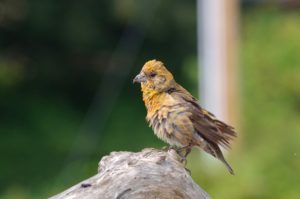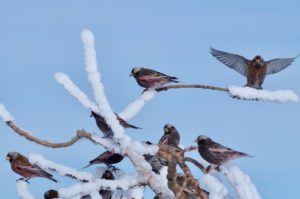By Alex Patia
Alex Patia is a birder and naturalist who works for Teton Science Schools as a wildlife guide. He lives in Jackson with his husky, Mia.
It’s no secret that winter in Jackson Hole is harsh for wildlife. Many animals migrate out of the area to avoid the deep snow and frigid subzero temps that occur here. You likely know about some of our more charismatic mammals that tough out the winter here, like the elk and bighorn sheep on the National Elk Refuge, but many bird species also stay for the winter. If you don’t normally pay much attention to birds you could be forgiven for thinking that ravens and magpies are the only birds that stick around for winter, they are certainly some of the most abundant and conspicuous winter residents we have!
Even if you are looking for birds in winter you’ll likely only encounter 10-30 species in a day around Jackson. Given how hard it can be to find many birds in winter it may surprise you to find out that 80 species of birds can be found in Teton County, Wyoming every winter. I have put together a list of these 80 bird species and how likely you are to encounter them as well as a list of 40 additional species that have been documented in Teton County but do not normally occur most winters. In this post I want to tell you about some of these fascinating species, their adaptations for surviving the cold, and what you can do to help the birds!
I could tell you about all 80 species of birds that reside in Teton County, Wyoming for winter, but that would require writing a book, so instead I want to highlight some winter birds that can be found right in your backyard. Specifically, I am choosing to discuss birds that will readily come to check out bird feeders and offer nice views vs. species that hide in dense forests all winter. Ravens and Black-billed Magpies may be the easiest corvids to see but if you live in an area within or near forest you may be treated to other members of this bird family including Clark’s Nutcrackers, Steller’s Jays, and Canada Jays. These three corvids breed high in the mountains but in winter they will move to lower elevations and may even visit your bird feeders! In milder winters Jackson Hole can also get Blue Jays, very different from their cousin Steller’s Jays with paler blue backs, white underside, and no black crest.

Black-capped Chickadee by Alex Patia
There are two families of small forest dwelling birds that are likely familiar because of how curious they can be around humans and how objectively cute they are: chickadees and nuthatches. Our two chickadee species are Black-capped and Mountain Chickadees, commonly seen year round but more often in small flocks in winter. Both have black heads and pale gray bodies but the Mountain Chickadee has a distinct white eyebrow that is slanted enough to give them an adorably angry expression. Black-capped Chickadees give the familiar “chicka-dee-dee-dee” call that is typically an alarm call to warn all small birds. The greater the danger the more “dee”s they will add. Nuthatches are skilled at climbing tree bark and will go in any direction, oftentimes going down headfirst or even hanging upside down. The Red-breasted Nuthatch is more common than it’s much larger cousin the White-breasted Nuthatch but both will readily visit feeders. These birds are well named because the best way to tell them apart is indeed the color of the breast.
In much of the lower 48 states winter is the best time to see native sparrows at backyard bird feeders… but not in Jackson. Even the hardy sparrow Dark-eyed Junco, a sign of winter affectionately referred to as “snow birds” in the eastern US, only winter in small numbers here in Jackson Hole. But what we lack in sparrow diversity in winter we make up for with finches! Many of our winter finch species can be found year round here, but some like Black Rosy Finches, Evening Grosbeaks, and Pine Grosbeaks spend most of the year high in the Tetons and only descend to Jackson occasionally in winter. The most familiar and abundant backyard finches are House Finches and American Goldfinches, both of which are generally most commonly seen in town, especially in winter, as they do quite well in urban environments.
Cassin’s Finches look somewhat similar to House Finches but with a thinner bill, pink color on males, and thin crisp streaks rather than wide blurry streaks on the females. Pine Siskins, a smaller and less yellow cousin of the American Goldfinch, can form huge flocks in winter and will make themselves known with their loud “zeeeeeee” calls. Red Crossbills are common year round but unlike other finches they will rarely visit feeders, instead preferring to use their specialized bills to open the cones of specific conifer trees.

Bathing Red Crossbill by Alex Patia
Here in Jackson Hole we primarily have type 5 or Lodgepole Red Crossbills that have bills just the right size for opening Lodgepole pine cones. They will also feed on Douglas fir and Engelmann spruce cones. White-winged Crossbills are much more seldom seen, as they are a more irruptive species, meaning they may venture south or to lower elevations in huge flocks some years but will be notably absent other winters.
Evening Grosbeaks, a giant yellow finch with black wings and tail, are similarly irruptive and highly nomadic moving around throughout the winter. If you see Evening Grosbeaks in your yard count yourself lucky and savor the moment! Also highly nomadic are the Gray-crowned and Black Rosy Finches. Gray-crowned Rosy Finches are strictly a winter visitor to Jackson Hole as they breed in mountain ranges closer to the Pacific coast from the Sierra Nevada and north to the tundra of Alaska. Black Rosy Finches breed in the high alpine of a few isolated locations around the interior West including the Tetons.

Rosy Finches by Alex Patia
One adaptation Rosy Finches have for frigid nights is roosting in large communal flocks inside caves, rock crevices, barns, and old Cliff Swallow nests! Every couple of years Common Redpolls will appear, often among large flocks of Pine Siskins to which they look similar save for a stubby yellow bill, namesake red cap, and pinkish breast on males.
Lastly, if you are very very lucky you may have my favorite finch visit your yard: the Pine Grosbeak. This is a truly giant finch with bright red head and breast on males and a more subdued but still beautiful yellow head and gray body on females. Pine Grosbeaks spend most of their year in subalpine forests but will come to lower elevations in winter to visit feeders or like Cedar and Bohemian Waxwings they will feed on lingering fruit in hawthorns or ornamental cherry trees.
If you are wanting to attract birds to your yard and help improve their survival through the cold, harsh winter you only need three things: food, shelter, and water. You may think that you’ll need a heated birdbath to supply birds with an ice-free water source, but most birds will readily eat snow as a water source. So, you really only need two things: food and shelter. If you have any large native trees or dense shrubs you not only have shelter but also food in the form of hibernating insects in the bark and seeds in trees. You can supplement bird’s normal diet by putting out bird feeders but there are a few things you should consider with any bird feeder setup. If you’re not wanting to feed or attract rodents the feeders will need to be hanging from a pole more than ten feet from the nearest trees or branches and with a baffle or metal cone about halfway up the pole so rodents cannot climb up.

Red-breasted Nuthatch, a common visitor to backyard feeders, by Alex Patia
The feeders should also be high enough up that a bear cannot reach them, especially if you intend to feed the birds outside of winter. And for the sake of the bird’s health please, please clean your feeders! If you never clean your feeders birds will get sick as a result by spreading diseases like salmonella (usually spread by lethargic Pine Siskins) and conjunctivitis (spread by House Finches with swollen eyes) especially if bird droppings are allowed to accumulate.
There is a very easy way to avoid your feeders become ground zero for a bird pandemic though, simply use bleach water or hot soapy water to clean them (a brush with a long handle is great for getting inside the feeder), rinse thoroughly afterwards, and let them dry completely before placing back outside. Try to only put out enough birdseed that will get eaten in a week or less to minimize mold and bacteria growth on the food, and then you can simply clean the feeders between filling them. I recommend feeding nyjer, black oil sunflower seeds, and suet. Avoid seed mixes with milo and millet as most native birds don’t eat these, but rodents and invasive European Starlings and House Sparrows will! If you follow these tips your feeders should stay pest and disease free!
As you may know, the February challenge for Nature Mapping is to report finches. Because most finches are so irruptive with huge fluctuations in movements, range, and population size year-to-year any and all data on when and where they do occur can be incredibly useful to better understand their changing populations. Hopefully, with this list of common winter backyard birds you will feel confident in spotting and reporting the feathered friends visiting your backyard this winter.
Happy birding and stay warm!
